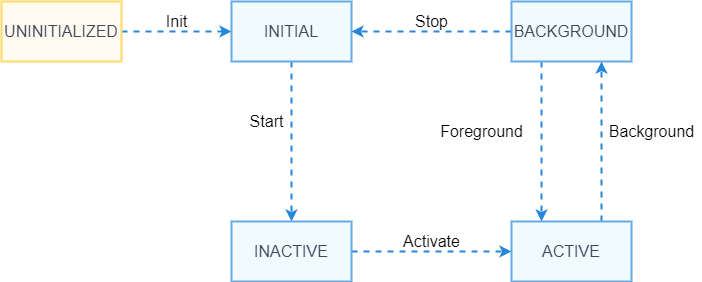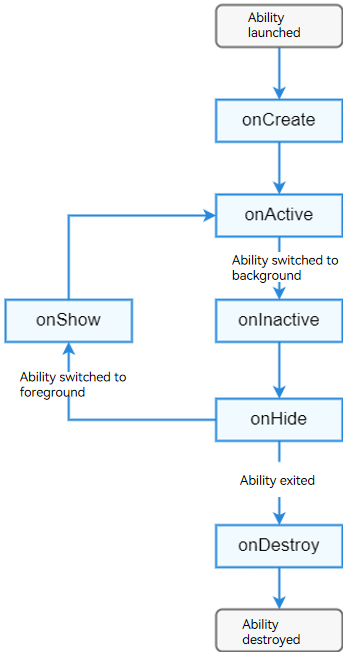harmony 鸿蒙PageAbility Lifecycle
PageAbility Lifecycle
The PageAbility lifecycle defines all states of a PageAbility, such as INACTIVE, ACTIVE, and BACKGROUND. The figure below shows the lifecycle state transition.
Figure 1 PageAbility lifecycle

Table 1 PageAbility lifecycle states
| State | Description |
|---|---|
| UNINITIALIZED | The PageAbility is not initialized. This is a temporary state, from which a PageAbility changes directly to the INITIAL state upon its creation. |
| INITIAL | The PageAbility is initialized but not running. The PageAbility enters the INACTIVE state after it is started. |
| INACTIVE | The PageAbility is visible but does not gain focus. |
| ACTIVE | The PageAbility runs in the foreground and has focus. |
| BACKGROUND | The PageAbility runs in the background. After being re-activated, the PageAbility enters the ACTIVE state. After being destroyed, it enters the INITIAL state. |
You can override the lifecycle callbacks (as described in the table below) in app.js or app.ets.
Table 2 PageAbility lifecycle callbacks
| API | Description |
|---|---|
| onCreate() | Called when the ability is created for the first time. You can initialize the application in this callback. |
| onDestroy() | Called when the ability is destroyed. In this callback, you can make preparations for application exit, such as recycling resources and clearing the cache. |
| onActive() | Called when the ability is switched to the foreground and gains focus. |
| onInactive() | Called when the ability loses focus. An ability loses focus when it is about to enter the background state. |
| onShow() | Called when the ability is switched from the background to the foreground. In this case, the ability is visible to users. |
| onHide() | Called when the ability is switched from the foreground to the background. In this case, the ability is invisible to users. |
The following figure shows the relationship between lifecycle callbacks and lifecycle states of the PageAbility.
Figure 2 Relationship between lifecycle callbacks and lifecycle states

NOTE
- The PageAbility lifecycle callbacks are synchronous.
- The app.js file provides only the onCreate and onDestroy callbacks, and the app.ets file provides the full lifecycle callbacks.
你可能感兴趣的鸿蒙文章
harmony 鸿蒙Using Explicit Want to Start an Application Component
harmony 鸿蒙Using Implicit Want to Open a Website
harmony 鸿蒙AbilityStage Component Container
harmony 鸿蒙Accessing a DataAbility
harmony 鸿蒙Accessing a DataShareExtensionAbility from the FA Model
harmony 鸿蒙AccessibilityExtensionAbility
harmony 鸿蒙Common action and entities Values
- 所属分类: 后端技术
- 本文标签:
热门推荐
-
2、 - 优质文章
-
3、 gate.io
-
8、 golang
-
9、 openharmony
-
10、 Vue中input框自动聚焦